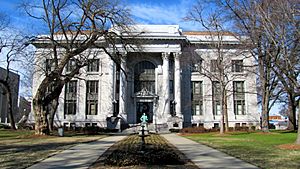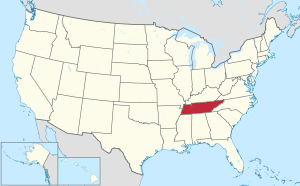Hamilton County, Tennessee facts for kids
Quick facts for kids
Hamilton County
|
|||
|---|---|---|---|

Hamilton County Courthouse in Chattanooga
|
|||
|
|||

Location within the U.S. state of Tennessee
|
|||
 Tennessee's location within the U.S. |
|||
| Country | |||
| State | |||
| Founded | October 25, 1819 | ||
| Named for | Alexander Hamilton | ||
| Seat | Chattanooga | ||
| Largest city | Chattanooga | ||
| Area | |||
| • Total | 576 sq mi (1,490 km2) | ||
| • Land | 542 sq mi (1,400 km2) | ||
| • Water | 33 sq mi (90 km2) 5.8%% | ||
| Population
(2020)
|
|||
| • Total | 366,207 | ||
| • Estimate
(2023)
|
379,864 |
||
| • Density | 635.8/sq mi (245.47/km2) | ||
| Time zone | UTC−5 (Eastern) | ||
| • Summer (DST) | UTC−4 (EDT) | ||
| Congressional district | 3rd | ||
Hamilton County is a county in the state of Tennessee. It's located in the southern part of East Tennessee, right on the border with Georgia.
In 2020, about 366,207 people lived here. This makes it the fourth-most populated county in Tennessee. The main city and county seat is Chattanooga, which sits along the Tennessee River. The county got its name from Alexander Hamilton, who was the very first Secretary of the Treasury for the United States. Hamilton County is one of 95 counties in Tennessee. It's also part of the larger Chattanooga metropolitan area. The county was officially created on October 25, 1819.
Contents
History of Hamilton County
For thousands of years, different groups of Native Americans lived in this area. They especially settled near the rivers and creeks. The land was home to the historic Cherokee Nation. In the early 1800s, the Cherokee were led by Chief John Ross.
The city we now call Chattanooga grew from a busy trading spot called Ross's Landing. This was a central place for the Cherokee Nation. Between 1819 and 1835, the Cherokee people were mostly moved out of this area. This happened through a series of agreements with the United States government.
Hamilton County was officially formed on October 25, 1819. It was made from parts of Rhea County and land that the Cherokee had given to the U.S. It was named after Alexander Hamilton. He was a hero in the American Revolutionary War and one of the Founding Fathers of the U.S.
In 1820, about 821 people lived in the county. The first county seat was in the home of Hasten Poe, who owned a popular tavern. Later, in 1822, the county seat moved to Ashael Rawlings's farm in Dallas, Tennessee. Finally, in 1835, the county seat was moved to Chattanooga, where it is today.
Hamilton County during the Civil War
During the American Civil War, Hamilton County was important for making gunpowder. There was a big mine on Lookout Mountain that produced saltpeter. Saltpeter is a key ingredient for gunpowder. Robert Cravens owned the land and operated the mine.
In 1862, the Confederate army took over the mining operation. They mined the cave until July 1863. Mining stopped when the Union army, led by General Ulysses S. Grant, took control of Chattanooga. They stayed there until the war ended.
After the war, Tennessee rejoined the United States. In 1871, James County was created nearby. But in 1919, James County went bankrupt. It then became part of Hamilton County.
Geography
Hamilton County covers about 576 square miles. Most of this (542 square miles) is land, and about 33 square miles (5.8%) is water. Hamilton County is special because it borders 10 other counties!
Amazing Natural Areas
Raccoon Mountain Caverns
Raccoon Mountain Caverns is a cool cave located about 8 miles northwest of downtown Chattanooga. It was first explored in 1929 and opened to the public in 1931. The cave is very long, with over 5.5 miles of explored passages!
A special spider called the Crystal Caverns Cave Spider (Nesticus furtivus) lives only in this cave. If you're lucky, a cave guide might point one out to you!
Ruby Falls Cave
Ruby Falls Cave is another amazing cave. It's located on the side of Lookout Mountain, south of Chattanooga. This cave was found by accident in 1928. Workers were drilling an elevator shaft to reach another cave, and they broke into Ruby Falls!
The cave developer, Leo Lambert, named the beautiful waterfall inside after his wife, Ruby. Ruby Falls opened to the public in 1930 and became very popular. It's the only cave open to visitors there now.
Lookout Mountain
Lookout Mountain is a famous area with places like Point Park and Sunset Rock. Point Park is a national military park. It honors a big battle that happened on Lookout Mountain during the American Civil War. Lookout Mountain was also where the last battle of the Cherokee Indians took place. It was even a base for General Ulysses S. Grant's troops during the Civil War.
Neighboring Counties
- Bledsoe County, Tennessee – north
- Rhea County, Tennessee – northeast
- Meigs County, Tennessee – northeast
- Bradley County, Tennessee – east
- Whitfield County, Georgia – southeast
- Catoosa County, Georgia – south
- Walker County, Georgia – south
- Dade County, Georgia – southwest
- Marion County, Tennessee – west
- Sequatchie County, Tennessee – northwest
Protected Natural Areas
- Chickamauga and Chattanooga National Military Park (part)
- Booker T. Washington State Park
- Chickamauga Wildlife Management Area (part)
- Justin P. Wilson Cumberland Trail State Park (part)
- Falling Water Falls State Natural Area
- Harrison Bay State Park
- North Chickamauga Creek Gorge State Park (part)
Main Roads
 I-24
I-24 I-75
I-75 I-124
I-124 US 11
US 11 US 27
US 27 US 41
US 41 US 64
US 64 US 72
US 72 US 74
US 74 US 76
US 76 US 127
US 127 SR 2
SR 2 SR 8
SR 8 SR 17
SR 17 SR 27
SR 27 SR 58
SR 58 SR 60
SR 60 SR 111
SR 111 SR 153
SR 153 SR 312
SR 312 SR 317
SR 317 SR 318
SR 318 SR 319
SR 319 SR 320
SR 320 SR 321
SR 321
People of Hamilton County
| Historical population | |||
|---|---|---|---|
| Census | Pop. | %± | |
| 1820 | 821 | — | |
| 1830 | 2,276 | 177.2% | |
| 1840 | 8,175 | 259.2% | |
| 1850 | 10,075 | 23.2% | |
| 1860 | 13,258 | 31.6% | |
| 1870 | 17,241 | 30.0% | |
| 1880 | 23,642 | 37.1% | |
| 1890 | 53,482 | 126.2% | |
| 1900 | 61,695 | 15.4% | |
| 1910 | 89,267 | 44.7% | |
| 1920 | 115,954 | 29.9% | |
| 1930 | 159,497 | 37.6% | |
| 1940 | 180,478 | 13.2% | |
| 1950 | 208,255 | 15.4% | |
| 1960 | 237,905 | 14.2% | |
| 1970 | 254,236 | 6.9% | |
| 1980 | 287,740 | 13.2% | |
| 1990 | 285,536 | −0.8% | |
| 2000 | 307,896 | 7.8% | |
| 2010 | 336,463 | 9.3% | |
| 2020 | 366,207 | 8.8% | |
| 2023 (est.) | 379,864 | 12.9% | |
| U.S. Decennial Census 1790–1960 1900–1990 1990–2000 2010 2020 |
|||
In 2020, there were 366,207 people living in Hamilton County. There were 148,157 households.
In 2010, the population density was about 620 people per square mile. The county's population was made up of different groups. About 74.75% were White, 20.21% were Black or African American, and 4.46% were Hispanic or Latino.
The average age in the county was 39.3 years old. About 21.58% of the people were under 18. About 14.69% were 65 or older. More than half of the population (51.88%) were females.
Education
Hamilton County has several colleges and universities. It also has many public schools.
Colleges and Universities
- Chattanooga State Community College – website
- Southern Adventist University – website
- University of Tennessee at Chattanooga – website
- Richmont Graduate University – website
Public Schools
The public schools in Hamilton County are managed by Hamilton County Schools.
Communities
Hamilton County has several cities, towns, and other communities.
Cities
- Chattanooga (county seat)
- Collegedale
- East Ridge
- Lakesite
- Red Bank
- Ridgeside
- Soddy-Daisy
Towns
Census-Designated Places
Unincorporated Communities
- Bakewell
- Balmoral
- Birchwood (partial)
- East Brainerd
- Georgetown (partial)
- Shady Grove
See also
 In Spanish: Condado de Hamilton (Tennessee) para niños
In Spanish: Condado de Hamilton (Tennessee) para niños




